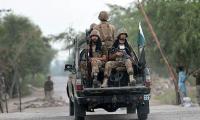The devastating death of 10-year-old Amal Umer on August 13 shocked the entire nation. The appalling details of the events that resulted in her tragic demise were shared by her parents on various media outlets and caught the attention of the country’s highest authorities.
The chief justice of the Supreme Court took suo-motu notice of the case and formed a special committee to investigate the matter and propose solutions. Responding to the incident, Sindh Chief Minister Murad Ali Shah announced that the provincial government would introduce various reforms to fix the loopholes in the system that became apparent after this tragedy.
If we dig deeper into the real reasons that led to Amal’s death, we realise that there are numerous shortcomings in the overall system. In addition to the reckless actions of untrained police officers who opened fire in a crowded public space, what has possibly emerged as a major cause of concern is the lack of adequate emergency medical services for the citizens of Karachi. An ambulance could not reach Amal as fast as it should have because there are merely 60 life-saving ambulances (run by the Aman Foundation on a not-for-profit basis) in a city of 20 million that requires a minimum of 200 ambulances as per WHO guidelines.
The chief minister took notice of this alarming fact and pledged that the government will provide adequate support in helping the Aman Foundation sustain its existing fleet of 60 ambulances, add another 40 ambulances by December 2018, and eventually reach the targeted number of 200 ambulances by December 2019. This plan was announced on the floor of the Sindh Assembly in a special budgetary session held on September 30, 2018.
It would be an understatement to say that this is the need of the hour. The burning question at this point is gauging what progress has been made on this promise more than a month after it was announced. Every day brings an avoidable loss of live due to the dearth of this critical service.
Aman Ambulance receives up to 1,000 calls for emergencies every single day, out of which they are only able to cater to 300. This means that on-the-spot decisions have to be made to determine which of these emergencies need to be prioritised or, in other words, which of these lives have to be saved – a tough decision to say the least.
Decisions are made on the basis of an international medical priority dispatch system (MPDS) – the same system that is currently being used in 40 or more countries of the world, including the UK and the US. The rest of the emergencies are either refused or redirected to other private ambulance services.
The problem with this is that these other ambulatory fleets are operating merely as transportation services, with limited or no medical equipment or specialised training. As a result, they aren’t able to provide immediate, adequate and en-route medical assistance. This results in the loss of crucial time that could potentially be spent preventing major suffering or, in some cases, even death.
The provision of healthcare services, both emergency and non-emergency, is the responsibility of the state. Despite paying heavy taxes, citizens are unfortunately deprived of quality medical assistance in our country. There are a small percentage of well-to-do individuals who can afford to pay for healthcare in the private sector. Shockingly, there are certain facilities within the country that are not even available for them. The same was the case with Amal, whose parents could afford to pay for her treatment but were let down by the system when they needed it the most.
It is no less than disgraceful and loathsome that Karachi, which is considered to be the financial hub of the country, lacks the most fundamental healthcare facilities like a proper, government-backed and integrated emergency response system.
Countless people suffer on a daily basis because they aren’t able to receive the right kind of immediate medical attention. This ranges from health concern, such as cardiac arrests, to tragic incidents, such as traffic accidents, bomb blasts or gun violence. Not all of them make headlines, but that doesn’t make the suffering of those who experience them is any less important.
As far as our healthcare system is concerned, we are in the middle of a national emergency. What is it going to take for the government to finally step up and put in place the required infrastructure? Another natural disaster like the 2005 earthquake? A tsunami? Or the loss of another Amal?
The writer is a communicationsprofessional and freelance writer based in Karachi. Twitter: @ambarahmed_
A health worker administers polio vaccine drops to a child during a door-to-door polio vaccination campaign in Lahore,...
Representational image. — APP FilePakistan today is sinking into a dark hole, having to borrow money even to pay off...
An aeroplane of the national flag carrier of Pakistan is seen in this file photo. — AFPWhile Pakistan considers...
Representational image of a graph depicting various variables. — APP/FileInitiated by the centre and fiercely...
In this picture taken on April 16, 2023, people throng a market area during shopping in Lahore. — AFPOne of the...
Honour crimes also target men. In Sikandar Ali Lashari vs The State, SHC upheld conviction passed by ATC for honour...







